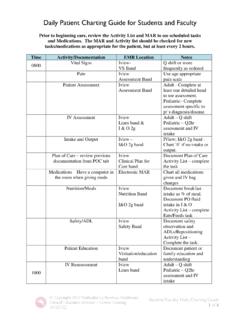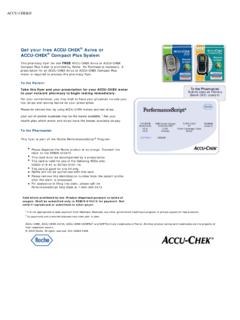Transcription of The Accu-Chek Inform II Whole Blood Glucose Procedure is ...
1 Accu-Chek Inform II Competency Training Material The Accu-Chek Inform II Whole Blood Glucose Procedure is located on the Clinical Policies site located on Molli (Methodist s intranet). 1. General considerations a. Positive patient identification is accomplished by scanning the armband on the patient. b. The correct patient identifier is the FIN# (financial number not the medical record number) c. The Accucheck Inform II meter will identify both the patient and the operator by scanning the patient s armband and the operator s hospital badge. d. The correct operator badge number is located in the upper corner of the hospital badge. 2. Specimen type and collection a. Only Whole Blood may be used for Glucose testing. Cord Blood may not be used to dose the test strip. b. Patients who are edematous or have impaired peripheral Blood flow to the fingertips should not be tested utilizing the Accucheck equipment.
2 These patients should have a venous sample drawn and testing performed in the main laboratory. c. Once the appropriate finger site has been prepared, the first drop of Blood must be wiped off and the second Blood sample used for Glucose testing. d. Blood sample must be adequate. If the sample is obtained by squeezing the finger repeatedly, then the result may be in question due to tissue fluid instead of Blood being tested. e. The entire yellow area on the test strip must be filled with Blood . If any yellow is still showing, then additional Blood maybe added up to 15 seconds after the first Blood was applied. f. If repeat testing is required , then another finger must be prepped and another finger stick performed. It is not acceptable to use the original collection site for repeat testing. g. There must not be any liquid alcohol left on the prep site prior to performing the actual finger stick.
3 Mixing alcohol and the Blood specimen will result in erroneous results. h. Blood must not be taken from an isolation room to perform a Glucose finger stick. The instrument may be placed in a glove or contained in a bag and taken into the patient s room and testing be performed. i. Once testing is completed, then required decontamination of the operator s hands and equipment must be performed prior to using the instrument on another patient. Operator must remove gloves, wash hands, and remove the instrument before leaving the isolation room. j. After each patient use, the instrument must be cleaned with a hospital-approved commercial wipe to insure that the instrument has been correctly decontaminated before testing the next patient. Follow the contact time of the product available. Use paper towel to dry the meter prior to next use.
4 K. No liquid must enter any port on the Accucheck meter. 3. Supplies/Reagents/Materials a. The expiration date for the controls is three (3) months after opening or until the expiration date on the control box if unopened. b. The date opened and the 3 month (90 days) expiration date MUST be written on the control solution container. The solutions will be dated by laboratory prior to placement on the unit. c. Strips are stored at room temperature and protected from humidity. The strip container top must be kept closed. 4. Equipment Care and Maintenance a. Analyzers operate with rechargeable batteries. The batteries are recharged when the meter is placed on the analyzer s docking station. If the batteries fail, then the meter needs to be reported to the Point of Care Coordinator (POCC) for replacement. b.
5 When cleaning a meter, gloves should be worn. These are considered biohazard equipment and the approved commercially prepared disinfectant is the recommended cleaning product. c. Never spray a solution or wipe the face of the meter or allow any liquid into the open ports on the meter body or internally within the docking base. Unit is electrical and damage to meter and base will occur. d. Any meter failure needs to be reported immediately to Roche for troubleshooting or to initiate a replacement meter. Roche contact number is 1-800-440-3638. 5. Quality Control and Patient Testing a. Quality control (QC) consists of two levels of testing solution that must be run once in a 24 hour period. The QC testing time is changed at the discretion of the Point of Care Coordinator to allow for testing on all shifts.
6 B. The instrument will indicate the time QC is performed. If performed prior to that time then QC will have to be performed again at the designated instrument time. c. QC must be performed and be successful before patient testing can commence. d. Quality Control testing is required with the following conditions: 1. Each time a new vial of the test strips is opened. 2. Any time a test vial has been left opened or if the strips have been exposed to extreme heat, humidity, or cold. 3. The analyzer has been dropped. 4. Patient s results (after repeat testing) do not appear to be consistent with the patient s condition. e. Both levels of QC material must be acceptable before patient testing may begin. Analyzer displays either a Pass or Fail after each level of QC is performed. If the controls fail, repeat testing is required.
7 Repeated failures require testing with fresh control solutions or using new strips. f. No courtesy testing is allowed. 6. Result/Ranges/ Values a. Once testing has been completed, the results of the analyzer will be downloaded to the patient s medical record either through the download dock or wirelessly. All results that are associated with a valid FIN# will post to that patient s medical record without further intervention. Results that are obtained without a valid FIN# are held in the data management system until such time that correct identification can be made by the POCC. This will cause a delay in result posting to a patient s chart. b. Reportable ranges are documented on the face of the analyzer after the patient test results are obtained. Confirmation information is also noted when results exceed the normal reportable range.
8 C. Results that read LO (<30 mg/dL) or HI (>580 mg/dL) should be repeated, and, if still in that range, a confirmation sample should been drawn and sent to the lab for results verification. DO NOT delay patient treatment waiting for the confirmation result from the laboratory. d. Adult alert values are less than 40mg/ dL or greater then 450 mg/ dL. These results must be handled appropriately for prompt patient management decisions. Notification of the physician or other responsible caregiver is documented in the patient s medical record by the appropriate caregiver. Department protocols determine notification criteria. e. Therapeutic values are determined by the protocol being followed and/ or physician preference. 7. Troubleshooting for Abnormal Patient Results a. Unusual or unexpected Glucose results or results that do not correlate with the patient s clinical status should be repeated and nursing protocol followed.
9 B. HI and LO results must be repeated to verify initial reading. If still HI or LO, then specimen must be sent to lab for valid result. 8. Procedural Notes/Limitations a. Caution should be taken to clear arterial lines before Blood is drawn and testing performed. Blood contaminated with fluids will cause erroneous results. b. Patients using peritoneal dialysis solutions (Galactose, xylose or maltose) should not have testing performed on Accucheck instrument. Venous samples should be drawn and specimens sent to the lab. c. Patients receiving certain types of intravenous immunoglobulin therapies ( Octagam or WinRho) should have Blood Glucose levels performed in the lab and not with a bedside meter.













![Accu-Chek Aviva Gebrauchsanweisung [PDF-Datei]](/cache/preview/7/1/b/0/5/c/3/3/thumb-71b05c330f2542a7d541375b4efa84ed.jpg)


